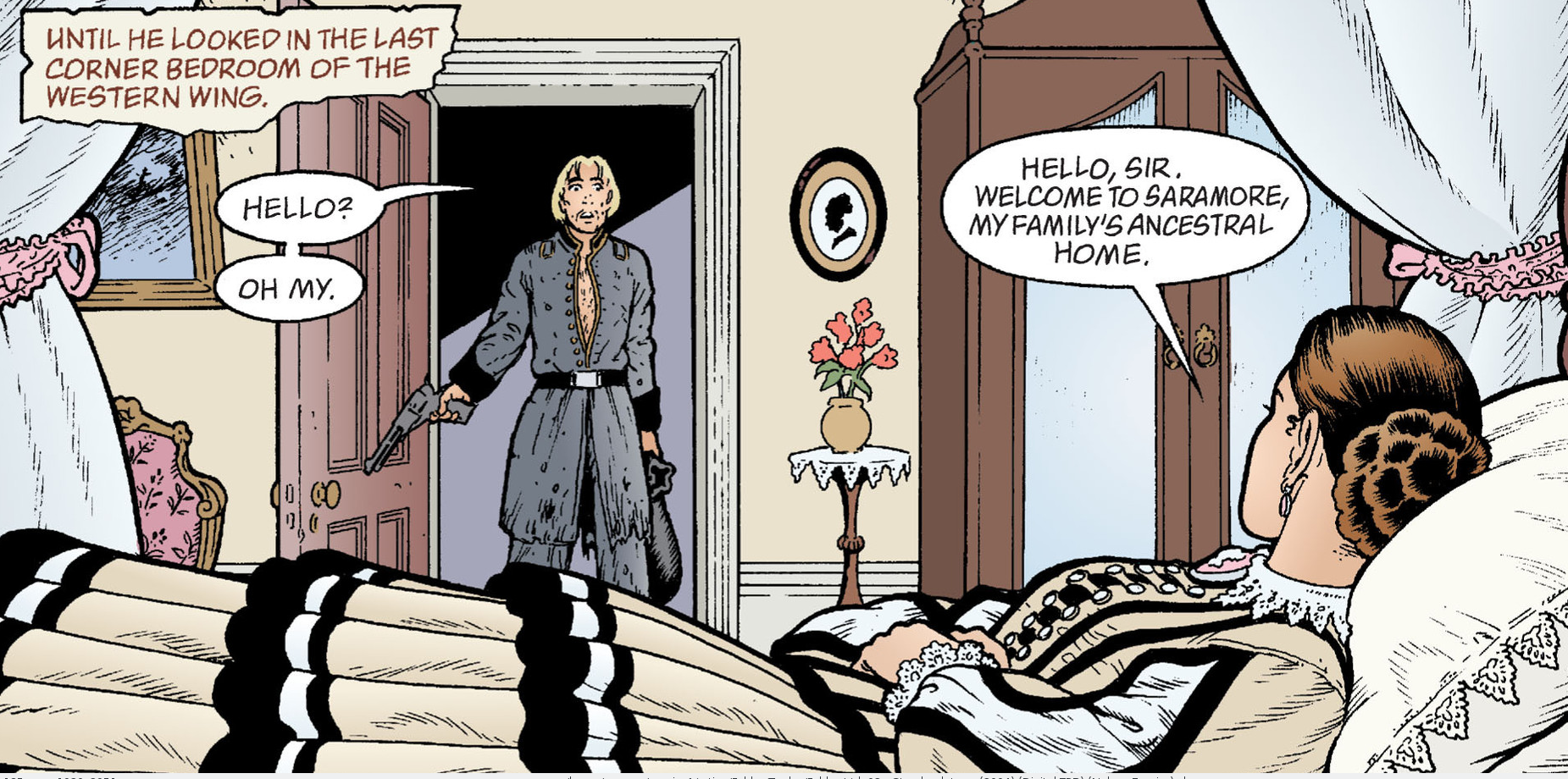Fables Volumes 1 and 2 were pretty intense. The first volume has Bigsby Wolf solving the alleged murder of Snow White’s sister, Rose Red. The second volume involved an uprising by the non-human fables at The Farm. All of this wrapped up with an introduction to the world of Fables which, by the way, includes The Adversary taking over all their lands in an allegory of Hitler taking over Europe and appeasement leading to greater damage. So, while it was quite the tonal shift, it was not entirely surprising that the next volume starts with a fun-loving tale of Jack of the Fables.
It turns out to only be a short respite from intense stories, but both the Jack story and the Briar Rose story function as palate cleansers while also serving to convey more of the backstory. In this sense, Bill Willingham has mastered storytelling from the very beginning of what would become a 150 issue series (plus spinoffs). I’ll return to the themes of these stories momentarily. The remainder of volume 3 involves Goldilocks, the chief agitator of the revolution on the farm, and Bluebeard attempting to murder Snow White and Bigsby. It then ends once again with a palate cleanser issue that deals with The Smurfette Problem among the Liliputians. Volume 4 opens up with Boy Blue recounting the story of the last set of refugees to make it from the fable lands to the real world. Again, Willingham both tells a poignant story that fits in with the refugee motif while also setting up the story of the rest of the volume. The majority of volume 4 involves an attack launched by the adversary and how the fables repulse it.
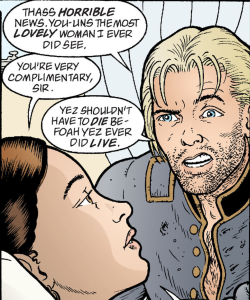
Part of what makes Jack’s story so much fun is that Willingham makes it trope-a-licious. The other part that makes it fun is that Jack is always out to try and find a way to get by without actually working. His constant scheming is fun, both when he gets away with it and also when he doesn’t. For example, he tries to trade on the fact that he pretends to be a Civil War hero to get food and to satisfy sexual needs. He’s initially rebuffed by a woman who would rather keep her southern pride and die a virgin. But when, through various circumstances, she ends up wanting to have sex with him, he’s saddled with a woman with an insatiable lust that he can’t wait to get away from.
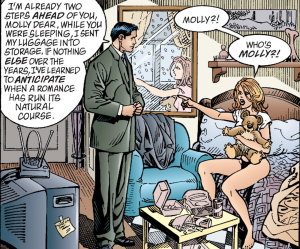
Briar Rose’s story starts off just as silly as Jack’s – she pricks her finger at Tiffany’s and that causes everyone there (and herself) to pass out. It moves to become a character study in the differences between Bigsby Wolf, Bluebeard, and Prince Charming. A reporter has figured out that the fables have been in New York city for hundreds of years. (Also shown by Jack’s story) What he thinks he knows is something I’ll leave spoiler-free, but the three main men of Fables have to figure out how to deal with him. After the being portrayed as the exaggerated jerk (in both senses of the word) in the first volume, Prince Charming becomes portrayed as one of the more nuanced characters in the trio. Bigsby, perhaps as a penance for his behavior in the old lands, is almost a perfect good, although he knows when to show violence. Bluebeard is a master of deception and is almost the polar opposite of Mr Wolf. He’s the charming patron of Fabletown while people are always doubting Bigsby. Charming, on the other hand, is seemingly only concerned with his own skin. This leads to his behaving alternately as a force for good or a force for evil (or at least jerkiness) – which ever suits him best at the time. He does seem to call on his sense of honor many times over these two books, but also seems ready to cast it off when it works best. It is that complexity that has elevated his character status in my eyes from haughty comic relief to a character I love to loathe for his slimey behavior. In fact, at the end of this issue he has taken up residence with Briar Rose (yet another ex of his), which serves as a subtle hint that he will be inserting himself into Fabletown quite a bit more in the future.
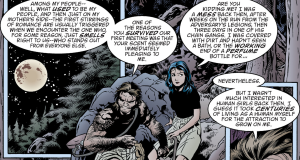
When we move on to the titular story, Storybook Love, things really pick up the pace once more. Before moving on to the two major plot points of this story, I’d like to touch on a few interesting threads from Snow White and Bigsby’s time together. First of all, in a move that’s since been tainted by a similar plot point in Twilight, the reason Bigby Wolf has become obsessed with Snow White is because of the way she smells to him. Second, along the thread of smelling pheremones and hormones and so on, Bigby is an emotion reader and can tell when Snow White’s been happy, sad, or jealous. This allows them to grow closer as they talk through these revelations although I like that Snow White was written to question whether this truly counts as being closer as it’s been one-sided for so long.
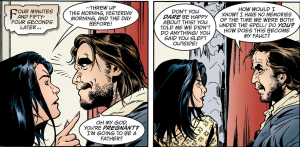
The first of the main plot points is a tough one to process at this point – it remains mostly unresolved as of the end of volume 4 – Bigby Wolf and Snow White have sex while under the influence of Bluebeard’s potion and Snow White becomes pregnant. I don’t think there are any complications for the character for these actions because they were under the influence of a potion. What complicates things is that Bigby Wolf knows this once they snap out of their trance. But while they spill other secrets and feelings that get them closer to each other emotionally, he does not spill the news. Snow has to find out the way many women with unplanned pregnancies do. The betrayal, of course, sets the relationship back.
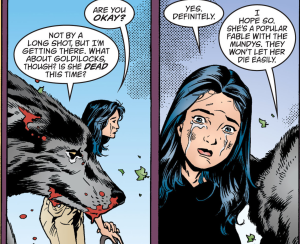
The other issue is one that’s more important narratively for this series. We learned in volume 2 that Snow White couldn’t die when Goldilocks shot her because she is too popular among the mundys. It didn’t completely invalidate things within this setting because Willingham clearly shows her suffering through her recovery. But can stories truly function well if all the characters the reader will care about are immortal? In volume 3 Bigby hopes that Goldilocks got hurt badly enough that even the mundys can’t resurrect her. In volume 4 we learn about a well into which people can be dumped in order to keep them dead. Not sure what the means in terms of the mundy popularity level. Perhaps only that this body cannot be that fable – perhaps others can take that shape as they did with the three giants in volume 2.
Once again, after all that drama, Willingham takes another little break with a fun story about how the Liliputians ended up in the real world without any women so they fought over Thumbelina. A soldier goes back into the adversarial world to get the magical barley corn that sprouted Thumbelina and then they had enough women.
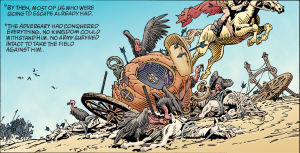
Volume 4 opens up with Boy Blue recounting how he ended up in the real world. The story ended up being far more personal to me than most stories ever are. I am very close to some people who have had to flee an adversary, with the adversary literally at their backs. Like the fables, they had to flee by boat and faced peril from attackers. In real life they were pirates who murdered some of these people’s relatives. Willingham does a good job of showing the equal struggles in those who flee and may feel cowardly and those who stay behind to fight to enable the refugees to leave, knowing death comes for them. Additionally, it provides some backstory on our characters – Bluebeard made his wealth ferrying folks to the new world. Prince Charming arrived on the last boat of refugees.
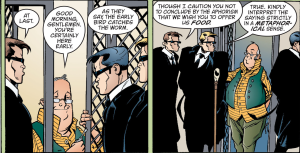
The rest of the volume concerns The March of the Wooden Soldiers. These wooden soldiers were great enemies both for their savage hatred of meat people and for their cool composure as they completed their tasks. I also loved their way of speaking which was something of a cross between a parody of mafiosos (think of those old Bugs Bunny cartoons with Bugsy and his hired hand) and AI robotic speak. Every time they spoke it made me chuckle. On a more serious note, the volume explores everyone coming together in a time of crisis as animals who had been on the wrong side of things in the rebellion came to help guard the New York site against the onslaught of the adversary. It also explores the deep bonds of family as Pinocchio decides to head back to the original lands in order to find Gepetto who he believes is being forced to make the wooden soldiers for The Adversary. We do see in the Boy Blue flashback that The Adversary has a human leading one of the armies so it’s entirely possible that Gepetto is working for him of his own free will.
Going from here we have to deal with one human who noticed the charms that were supposed to keep the mundys from knowing what happened and the knowledge that The Adversary is strong enough or emboldened enough to begin attacks on the real world.
Fables Vol 3: Storybook Love written by Bill Willingham with art by Mark Buckingham, Lan Medina, Bryan Talbot, Steve Leialoha, Craig Hamilton, Linda Medley, and Daniel Vozzo. (buy it here to support this website: Fables Vol. 3: Storybook Love) Fables Vol 4: March of The Wooden Soldiers written by Bill Willingham with art by Mark Buckingham, Craig Hamilton, P. Craig Russell, Daniel Vozzo, and Lovern Kindzierski. (Buy it here to support this website: Fables Vol. 4: March of the Wooden Soldiers
) Both lettered by Tod Klein.
